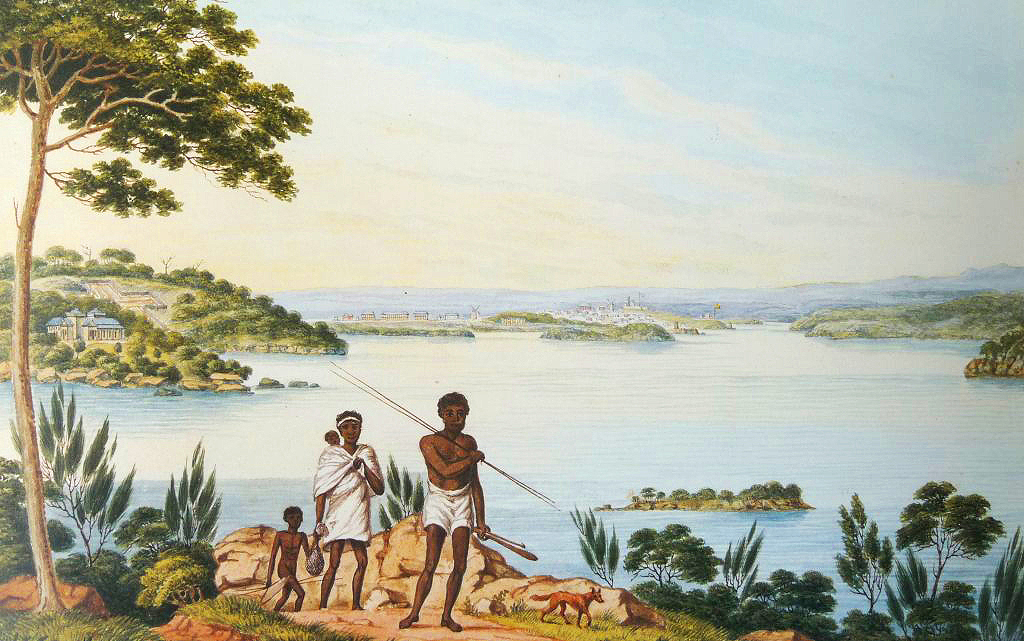Details about Aboriginal occupation of Hunters Hill is sketchy to say the least. This is not surprising because, apart from occasional rock engravings, middens and the tradition of passing down information from generation to generation orally, there was nothing written down by them.
Nevertheless historians and archaeologists have attempted over the years to piece together a factual fabric of aboriginal occupation from what little evidence exists. However the result of much of their research covers a wider area than just the Hunters Hill peninsula. For the aboriginal story of the suburb is an integral part of the whole human history of the Sydney basin.
While some observations were made by Governor Phillip’s survey party back in 1788, the most comprehensive recent research carried out to date was by Val Attenbrow in 1988. It is from her report, as well as from Hunters Hill, Australia’s Oldest Garden Suburb, by Bev Sherry, and other documents held within the Historical Society’s archives, which are available for viewing, that the following information is drawn.

It is generally accepted that the aboriginal people who occupied the peninsula belonged to the Wallumedegal or Wallumattagal clan. They were the traditional owners of this land. Their name was derived from either the word for snapper fish – wallumai – combined with matta, meaning a place of water or after the spiny rush plant which grows prolifically in the area, whose seeds could be used in damper and whose leaves were used to weave bags. Their language was known as Darug.
These people possibly referred to the area as Moco Boula, meaning two waters, specifically the Parramatta and Lane Cove Rivers which lie on each side of the peninsula. The name was originally used by one of the Municipality’s early pioneers, Jules Joubert. He claimed that this was how local aboriginal people had referred to the area. However he provided no source for his assertion.
As an aside, it is interesting to note that Joubert wanted to use the name of Moocooboola for the newly established Municipality. His peers were not as supportive of the idea and preferred Hunters Hill. Moocooboola exists, though, in the name of the local community festival, among other things.
The smallpox epidemic in 1789, brought by Europeans, is thought to have virtually wiped out the local aboriginal population. If the disease did not kill them, then those that remained were driven from the area by colonisation.
What is not as well-known are the several dozen archaeological sites spread around the municipality. Their exact whereabouts have been generally kept secret, which is partly a deliberate policy by the authorities to keep them safe and secure from overzealous enthusiasts and to deter vandalism.
As it is, their locations have become overgrown and mostly inaccessible and any evidence of aboriginal occupation has diminished, not least because of natural erosion.
Attenbrow cites some 47 sites recorded in Hunters Hill, which she estimates as representing an average density of eight sites per square kilometre and an average of three sites per kilometre of shoreline.
These sites indicate that aboriginal people conducted a range of activities on the peninsula. It is likely, though, that the length of each visit may have been only to eat a meal, from fish caught in the surrounding waters, or to stay just a few days. As the majority of the sites are close to the shoreline, this leads to the conclusion that access to the peninsula was mostly by canoe.
There are stated to be three main areas showing signs of aboriginal occupation – near Woolwich Dock, at Kelly’s Bush in Woolwich and in Boronia Park. There are also a couple of sites within private property, such as in Wybalena Road and Sea Street.
These sites have been recorded as being rock shelters, axe-grinding grooves in the rocks, middens made up of discarded shells of mussels, oysters, cockles and whelks and even human burial grounds.
The subject of the pictures in some seven of the rock shelters are not readily identifiable, having faded because of weathering or by graffiti which has obscured them.
According to Attenbrow, human skeletal remains were discovered in two rock shelters and in one open site. From one location, near Woolwich Dock, two skulls were recovered – one of a woman and the other of a juvenile aged about 11. A skull was also found at Wybalena Road. Two of the skulls were recorded as being in the possession of the Australian Museum.
